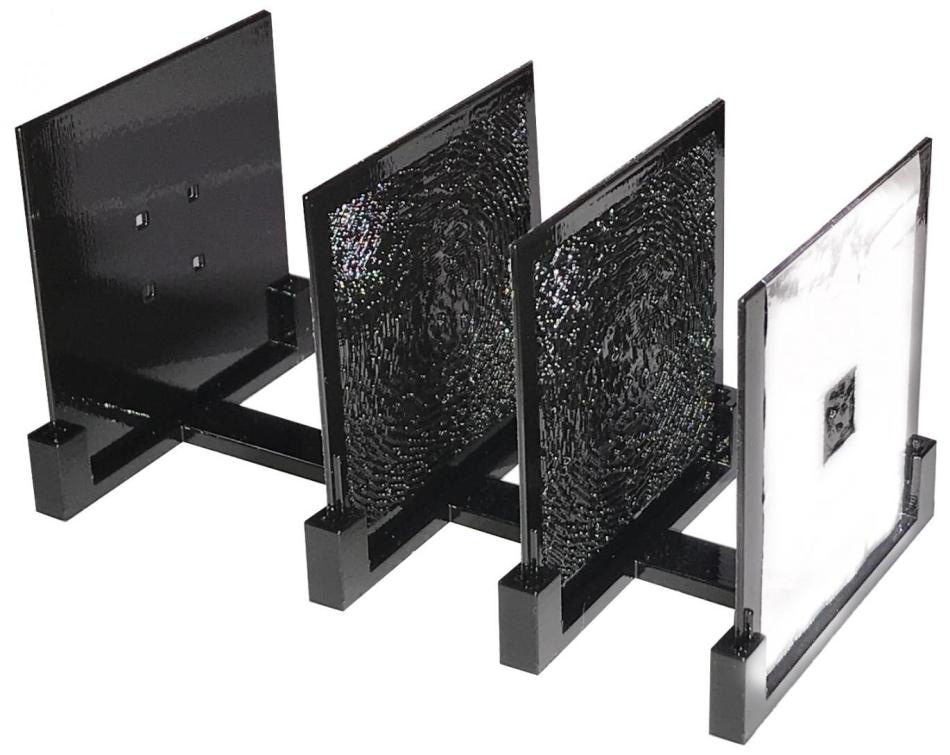Dec 5 2019
A diffractive deep neural network is an optical machine learning structure that is capable of combining deep learning with optical diffraction and light-matter interaction to design diffractive surfaces that collectively carry out optical computation at the speed of light.
 Prototype of a broadband diffractive deep neural network. Image Credit: Ozcan Research Group, UCLA.
Prototype of a broadband diffractive deep neural network. Image Credit: Ozcan Research Group, UCLA.
A diffractive neural network is initially developed using deep learning methods in a computer, followed by the physical fabrication of the engineered layers of the neural network using, for example, lithography or 3D printing.
Since the link between the input and output planes of a diffractive neural network is defined through diffraction of light via passive layers, the inference process and the related optical computation do not use up any power other than the light used to irradiate the object of interest.
Created by scientists at UCLA, diffractive optical networks offer a low-power, low-latency, and highly scalable machine learning system that can find many applications in autonomous vehicles, robotics, defense industry, etc.
Besides offering statistical inference and generalization to clusters of data, diffractive neural networks have also been used to design deterministic optical systems such as a thin imaging system.
In the previous demonstrations, diffractive network models were designed to process data through a single wavelength, and, therefore, required a monochromatic and coherent illumination source, unlike, for example, the ambient light that is incoherent and made up of a continuum of wavelengths, making it broadband.
To overcome this drawback, the UCLA team has engineered diffractive networks with the ability to process data using a continuum of wavelengths, widening this all-optical computation framework into broadband optical signals.
UCLA scientists showed the success of this new framework by developing a series of optical components that filter broadband input light into preferred sub-bands. Details of their work have been published in Light: Science & Applications, a journal of the Springer Nature.
These deep learning-based diffractive systems also regulate the exact location of each filtered band of radiation at the output plane, showing spatially controlled wavelength de-multiplexing in terahertz (THz) part of the electromagnetic spectrum.
After designing on a computer, these broadband diffractive networks were fabricated using a 3D printer and tested using a pulsed THz source producing a continuum of wavelengths between 60 and 3000 µm. The experimental results acquired with these 3D-printed diffractive networks exhibited an excellent agreement with their respective numerical designs, demonstrating the experimental robustness of broadband diffractive optical networks.
This study was headed by Dr Aydogan Ozcan, UCLA Chancellor’s Professor of electrical and computer engineering (ECE) and associate director of the California NanoSystems Institute (CNSI).
The other authors of this study are graduate students Yi Luo, Deniz Mengu, Muhammed Veli, post-doctoral researcher Dr Nezih T. Yardimci, Adjunct Professor Dr Yair Rivenson, as well as Professor Mona Jarrahi, all with the ECE department at UCLA.
Simultaneously analyzing and processing light across many wavelengths present unique opportunities to enhance the inference and generalization capabilities of diffractive optical networks to perform machine learning tasks such as all-optical object recognition, as well as to design deterministic and task-specific optical components, expanding the optical design space beyond the human intuition.
Dr Aydogan Ozcan, Chancellor’s Professor of Electrical and Computer Engineering, UCLA
This new technique is also generally applicable to different parts of the electromagnetic spectrum, including the visible band, thus signifying a critical breakthrough for diffractive optical networks toward their extensive utilization in advanced optical components and machine learning systems, covering an extensive range of applications in, for example, autonomous vehicles, robotics, and surveillance.